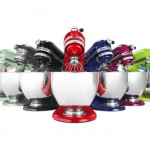By Damien Andrews
Most DIY spray painting is done on relatively small metal objects. Shelf brackets, door hardware, bicycle parts, grill attachments and even small propane tanks are among the countless articles that are likely to experience a spray painting during their service life.
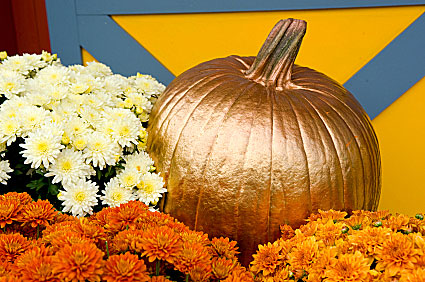
It’s not always necessary to get a perfect finish when spray painting, but for high visibility items and special parts, a perfect finish is absolutely the way to go. The following spray painting tips and tricks will ensure that your finished project has that perfect finish.
It’s really very simple to get a professional look to your spray painting projects, there are just a few things to remember. I guarantee that if you oblige the following tips and tricks, even you will be amazed at the superb finish you’ll achieve on your next spray painting adventure.
Perfect your spray painting technique and you’ll find a wealth of creative projects open up to you. Spray painting a small pumpkin with high gloss metallic gold spray paint makes an eye catching table piece for Thanksgiving. Use high gloss gold metallic or high gloss silver metallic on pine cones for some truly unique holiday decorations.
Spray Painting Tip #1: Properly prepare the surface. It should be free of rust, debris, oils, grease, water, old paint and dust. Use wire brushes, sand paper, emery cloth, files, steel wool or sand blasting to get the bare metal ready to accept the paint. Finally, use something like denatured alcohol or acetone to make absolutely positive that no oils remain on the surface. When this step is complete, avoid touching the metal with your bare hands – it leaves oils behind. Use a rag or disposable rubber gloves.
Spray Painting Tip #2: Protect areas of the item that you do not want to get painted. Masking tape will do this adequately for many jobs, but I prefer Safe Release™ Painter’s Tape by 3M when I am seeking the perfect finished job. Trim excess tape using a new hobby knife (also called a craft knife) or razor blade – not a shop knife. Remember while doing this to wear disposable rubber gloves so you don’t contaminate the prepared surfaces.
Spray Painting Tip #3: Professional spray painting is done in controlled environments. No direct sunlight, and no wind to blow dust and debris onto your work. You likely don’t have a spray painting room – so let’s make one – FREE! Simply go to a place in your town that has old cardboard boxes and get one that’s big enough to hold your work – with room to spare. You can get large boxes at appliance and office supply stores. Smaller boxes will be at your grocery stores. Assemble the bottom of the box and lay it on its side on some newspaper to catch overspray. Make sure the top flaps will stay open while you work – but don’t cut them off! The item you’re spray painting goes inside the box – about 2/3 of the way towards the front, and centered side-to-side. Make sure your working light will get inside the box when you start spray painting so you can see.
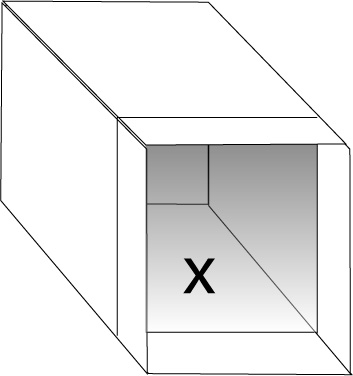
Here is a rough representation of a homemade, and free, cardboard paint box. The “X” shows about where to place the item for spray painting.
Spray Painting Tip #3b: For spray painting items too large to fit inside of a cardboard box, you can easily build a temporary spray painting room in your workshop or garage. Buy a roll of 10′ or 12′ wide construction plastic. Cut a piece for the floor that is about 6′ larger than the room will be. Now hang sheets from the ceiling using tape and/or tacks. Tape the hanging plastic to the floor plastic to prevent overspray from escaping, and to keep dust out. Make sure your “door” opening has a large overlap so the room can be closed off effectively. This is great for wrought iron furniture, bicycle parts and barbecue grills.
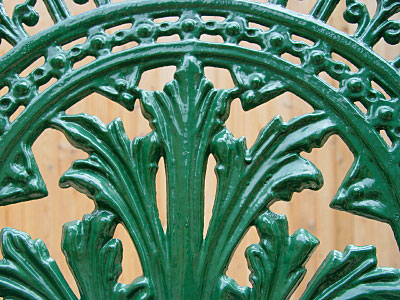
This very old, Victorian style wrought iron garden chair (the inside area of the seat back is shown) was taken in for sandblasting before spray painting. Ornate wrought iron is extremely difficult to prepare by hand for painting. Sand blasting leaves the metal in perfect condition to receive the primer coat. A project like this requires a temporary plastic painting room and takes about 10 days to completely paint and dry. But the results speak for themselves. This chair can sit out in the elements on the patio for 20 years before it will need attention again. Paint used: 1 can primer; 4 cans green; 2 cans glossy clear coat for extra protection.
Spray Painting Tip #4: Magnets! Magnets work great for holding your metal work while you’re spray painting it. You can grab the magnet and rotate it to adjust the item’s position without touching your work. I keep several magnets handy just for this purpose.
Spray Painting Tip #5: Use the recommended primer before applying your finish coats. Not only will this enhance protection and increase service life, it will allow your final coats to lay smoothly. As a bonus, since primers are more forgiving than spray paints, it’s a good time to practice your spray painting technique.

The list of colors available in spray paints is all but endless. There is a quality spray paint color for every project conceivable, including metallic colors and specialty paints and colors. Use high temperature spray paints for your grill. Remember when you’re picking your color that how the light will hit it causes minor variations in appearance: bright light brightens colors to a point, and then washes them out. Shadows diminish colors – as shown in the drawing. Indoor lighting also affects what you see. I take my selected spray paint cans to a window to see the cap color in natural light before I buy.
Spray Painting Tip #6: Use several coats of paint! Let me say that again for those people in the back of the room. Use several coats of paint! Since the item you’re spray painting can’t be suspended in midair, plan to paint, allow to dry, paint, allow to dry, reposition to get the missed areas, and so on. This approach is important with the primer, but it is critical with the finishing coats of paint. As a rule of thumb, figure every part of the metal will require at least three finishing coats to achieve a perfect finish.
Spray Painting Tip #7: It’s time to paint. Don your safety gear (mask and goggles – this is also a good time to slip on a pair of disposable rubber gloves) Remove the cap from your paint can and start shaking. Whenever you first start spray painting, vigorously shake the can for 45-60 seconds. Subsequent shakings, done while painting, can be for 5-10 seconds. Re-shake the can once for every 1-minute of spray painting. Now follow the steps below:
1. Test the spray paint nozzle. Hold the can 10″-16″ away from the outside of the BACK of the box and spray some paint on the box. If the paint splatters out onto the box – you need to return that can for a new one. The spray should be even and not leave large drops of paint on the box.
2. Shake the can while you go to the front of the box. When you’re ready to paint. Do NOT aim at your work! Aim at the inside side of the box and sweep across your work to the other side of the box. Do NOT stop and sweep back while the paint is hitting the article being painted – this will cause paint buildup and drips. Sweep up and down, side to side, around in circles – whatever your item requires – just never stop sweeping while the spray is hitting the work. Do NOT try to get full coverage with this first finish coat! This is to say: do not keep spray painting until you can no longer see any primer. It will all get covered properly with the subsequent coats.
3. When the item is painted, gently close over the box front and lightly seal it with masking tape to prevent dust and bugs from sticking to your work. Take your spray paint can outside, turn it upside down and depress the nozzle until no more paint comes out – this will keep your nozzle working great for the next coats. Replace the cap.
4. Wait until you’re sure the paint is absolutely dry. Open the box and repeat all of the above steps until the job is complete – at least three finish coats on all surfaces. I like 5-6 coats for my premium projects.
5. Carefully remove your dry, finished work and gently remove the tape SLOWLY, as needed. Have a hobby knife or new razor blade handy in case you need to make any slits or remove stubborn pieces of tape.
You should have a spray painting job that even a pro would envy. If you use the above technique with a glossy spray paint, you should have a mirror-like finish free of wrinkles, drips and dust bumps.
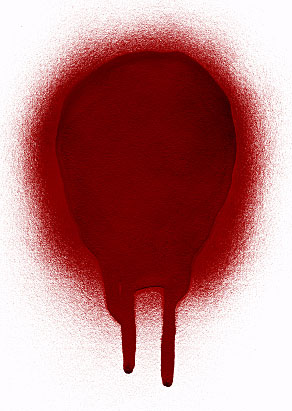
If you stop sweeping the spray paint can even for 1-second, you can expect to see something like this happen. If this happens to you, stop painting immediately and use a rag to remove all the fresh paint you can before it dries – terrycloth works best for this. Let the item dry completely. If there are still tiny paint bumps and flaws, try removing them carefully with fine steel wool or 200 grit emery cloth. If necessary, re-prime the area and begin again.
Following is a list of the suggested items for spray painting:
- Small, inexpensive magnets – I like the 1″x2″ plastic coated ones from the hardware store.
- Sand paper in varying grits, depending on the job.
- Emery cloth in varying grits, depending on the job.
- A wire brush.
- Steel wool: 0000 is what I prefer.
- Acetone or denatured alcohol.
- Rust removal chemical – ONLY if your rust is really bad. Otherwise use the tools and equipment listed for cleaning and preparing rusted metals.
- Disposable rubber gloves – I buy the large packs to save money.
- A metal file – fine is almost always the best choice.
- A hobby knife (like an X-ACTO™) and blades, and/or single-edge razor blades.
- Masking tape or Safe Release™ Painter’s Tape by 3M.
- Eye protection – goggles are recommended.
- An appropriate dust mask or respirator. If you create a plastic paint room, a proper respirator should be used.
- Your finish coat spray paint, and the recommended primer for it.
- Cleanup rags, turpentine, plastic trash bags for used gloves, etc.
- A proper size cardboard box.
- Old newspapers.
- A camera – because you’re gonna want to take pictures and brag about this spray painting job!
Pro-Tip: Practice makes perfect. Go ahead and spring for a couple of cans of quality spray paint to perfect your spray painting technique. Put a piece of aluminum foil onto a piece of cardboard – to simulate the metal surface you’ll be painting. Practice your sweeping motion and find a ‘just right’ distance from the work. It’s a small investment that pays big dividends when you are working on a special spray painting project. Don’t forget to clear your nozzle after each practice session so your paint keeps spraying like new for future sessions.


